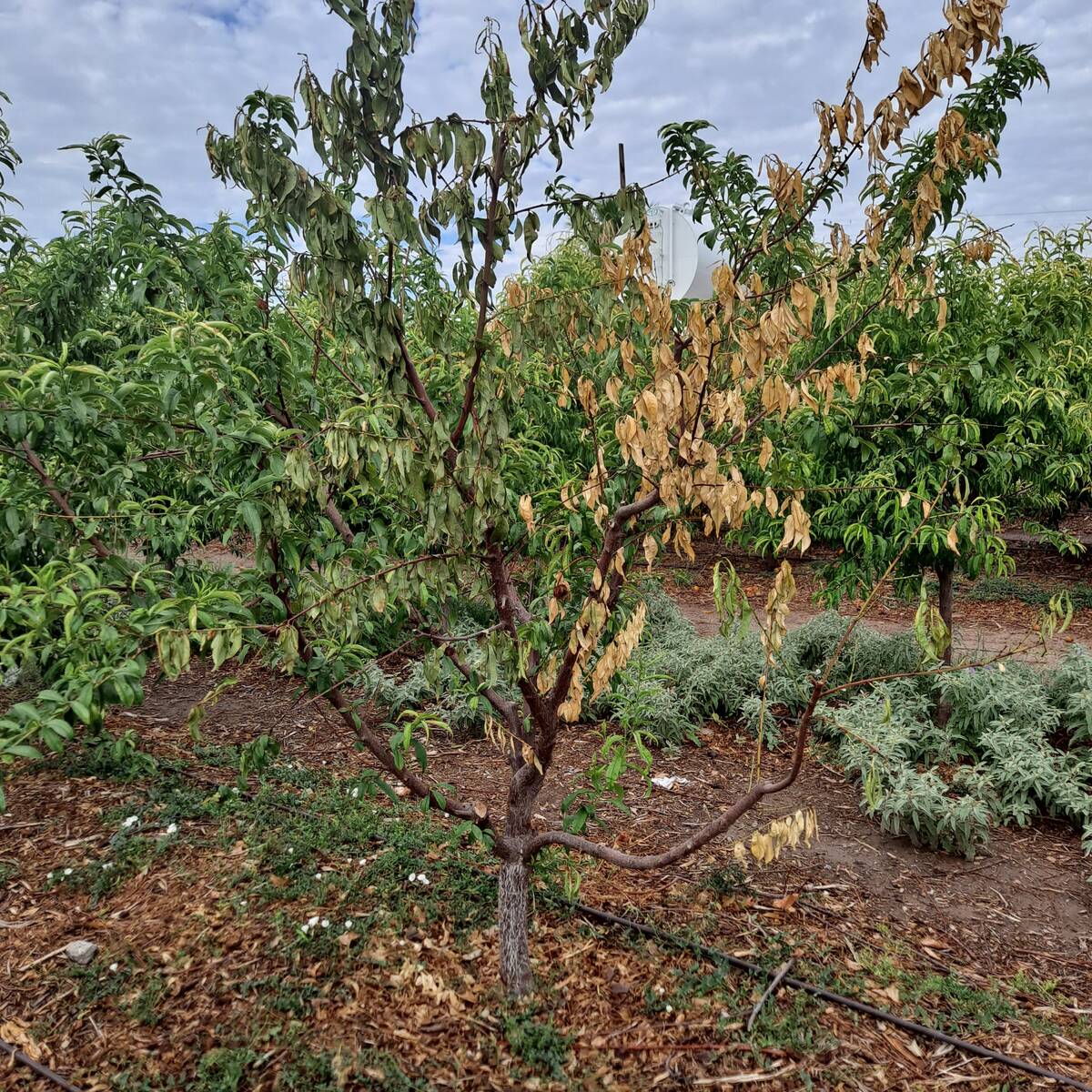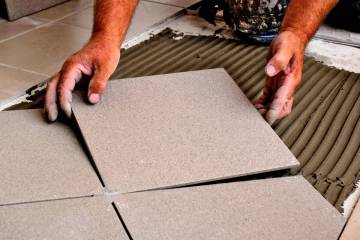Loss of shade can lead to sun damage, borer attacks
Q: I had an irrigation issue in July that caused some heat stress to all three of my plum and pluot trees. I believe this may have killed them. I lost my second pluot one limb at a time starting in August. I believe this was caused by borers. Can you let me know what you think and what to do to prevent this in the future?
A: The reason for the death of your ornamental plum was most likely because of boring insects, aka borers. In the hot desert, loss of shade from an irrigation problem leads to attacks on those areas by borers.
Leaf drop on the side of fruit trees on the west or south sides only needs about 20 minutes before sun-drenched limbs overheat and creates sun damage. Sun damage frequently leads to borer problems.
Keep the tree shaded and full of leaves when it’s young. Keep the lower limbs intact when they are young. Let the lower limbs shade the trunk as much as possible. Keep the trunk shaded until the tree establishes itself and can shade the trunk on its own as it gets older and the canopy is full of leaves.
Fruit trees standing by themselves, not surrounded by other trees and growing in hot areas of the landscape, may have the biggest problems with borers when first getting established.
What can you do? Try everything in your power to not lose shade in your fruit and ornamental fruit trees during the early or middle of summer. Or for that matter, any time of the year. Provide shade for young fruit trees and plant them in cooler parts of the landscape.
If leaf loss happens, assume the worst and use a chemical approach. Drench the soil with borer insecticide and sacrifice the fruit for next year. At least that way you save the tree.
If you are opposed to the use of chemicals, then use a nonchemical approach. This requires that you substitute inspections of the tree for borer activity frequently.
Borer activity in trees can be difficult to see. The best time to look for borers is the day after it rains.
Substituting the spray from a hose might substitute for rain. The activity is easy to see then because of the frass (sawdust, poop and sap) forced to the limb or trunk surface.
Extract insect borers with a clean knife if you can. Shade the area affected until sufficient shade is produced by the tree.
Q: My neighbor’s tree is planted next to our shared block wall. The roots of the tree have grown under the wall and have spread underneath my lawn. Their horticulturist indicated the roots in our yard would continue to grow regardless of whether the tree was removed and the lawn was kept. They suggested we remove the sod on our side of the fence, dig up the roots and keep trying. What do you say?
A: Predicting where roots are growing and if they can be removed or not can be tricky. What is known for sure is that your lawn does provide frequent watering and fertilizer so the tree roots will love that area.
The general rule of thumb is that established tree roots grow 2 to 2½ times the tree’s height in rainy areas. To visualize where they might be, visually lay the tree on its side and spin a circle with it. This area roughly describes where the tree’s roots can grow.
In the desert where rainfall is very limited, they grow into areas where there is water. Tree roots do not grow where there is no water. Tree roots grow best when they can get water and fertilizer regularly.
The tree’s primary growth comes from your lawn. Adding water to get the tree roots to grow in a different direction is futile unless the lawn and roots are removed.
I disagree with the horticulturist. The roots will stop growing and die if the tree is killed and removed.
What to do? Remove or cut the roots and install a root barrier to the inside of the wall. Commercial root barriers are sold, and licensed landscape contractors or certified arborists know how to install them correctly.
Q: Is this the best time to plant lantanas? Or is early spring better?
A: It doesn’t make any difference when they are planted if the maximum temperatures are in the 90s. Now with cooler weather, it is a great time to plant lantanas.
Plant them now to get them established in case it freezes this winter. If the tops are pruned they will grow back in the spring if they are damaged from winter freezing weather.
Q: I have a 3-year-old tangerine shrub. I got a good crop this year but sunscald got the fruit. Should I leave fruit on until it ripens or remove it?
A: Most citrus (in your case clementines or tangerines) produce fruit that is harvested as early as mid-November and may be kept on the tree until it starts flowering again in January or mid-February. I would harvest the fruit when it is ready this winter and not earlier.
These citruses originate from southeast Asia (semi to tropical) but are not desert plants that can handle our high light intensities, high temperatures and low humidity. The most attractive fruit is protected by growing inside the canopy of the tree which happens normally when the tree is larger and older.
When these trees are young, they produce most of their fruit outside the canopy where there is more damage to the fruit caused by our intense desert sun.
You can increase the number of fruit grown in the shade of its own canopy by making some shorter pruning cuts inside the canopy when pruning in early spring. Otherwise, keep the branches originating from the trunk as low on the tree as possible and do not remove the lower limbs until they get older.
Q: Underneath my pistache tree, I am finding a lot of small holes in the soil. Could they be from leaf-cutter bees? Do they burrow into the ground to make their nest? I have a lot of leaf cutters around as evidenced by their prolific leaf cutting. I’m also thinking that they’re relatively harmless to the tree.
A: Probably not. Most likely they are exit holes from cicadas.
Leaf-cutter bees usually breed in cracks and crevices above ground. When they do go below ground, they usually don’t make holes that large or any holes at all.
Cicadas feed on tree roots and leave these exit holes but are usually not a problem due to the small amount of feeding they do. Root loss is compensated by lightly fertilizing each year. I would not do anything but live with it if you see no other problems with the trees.
Q: Our privet leaves are being savaged by something. I can’t find any insects that are leaving the sawtooth edges around the outside of the leaves. Any advice?
A: Most likely the culprits are feeding at night when you aren’t there. Your picture of the damage to the outside edges of the leaves reminds me of adult root weevil damage.
The young ones, or grubs, feed on plant roots and the adults are more mobile so they can climb. Adult root weevils climb or fly (weevils can be weak flyers) and leave the protection of the soil to feed at night. You would need a flashlight to see them at night and you would look for them starting in early summer.
For more information on root weevil behavior look at https://extension.usu.edu/pests/ipm/notes_ag/fruit-root-weevils.
Partial control can be gotten by using sticky traps that are bought or homemade and hung in the shrub when damage is seen, usually during the summer months.
Getting total control requires the application of a soil-applied insecticide. Some of these insecticides are systemic and some are contact poisons. Systemic insecticides should be applied to the soil after your euonymus flowers in the spring to avoid poisoning honeybees. Contact insecticides can be applied at any time to the soil.
Bob Morris is a horticulture expert and professor emeritus of the University of Nevada, Las Vegas. Visit his blog at xtremehorticulture.blogspot.com. Send questions to Extremehort@aol.com.





























